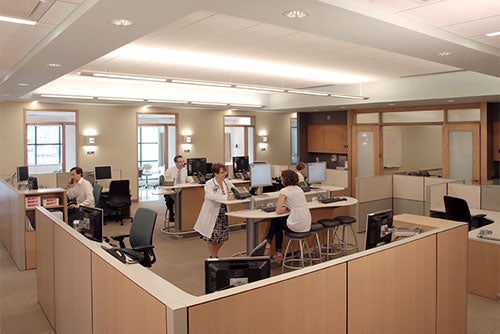Mass General facility helps to reinforce behavioral goals


The staff work area in the APF at Massachusetts General Hospital is designed to be reconfigurable as practice needs change
The Ambulatory Practice of the Future (APF), located on the campus of Massachusetts General Hospital in Boston, opened in July 2010, but the multidisciplinary team of physicians, patients, administrators, technology and systems experts, and other advisers that was charged with its design met for several years before the architectural team was engaged.
The team sought to develop a new model of care to radically improve the experience for patients and providers. They were committed to innovating behavior first so the design of the physical space matched their vision for collaboration among providers and with patients as partners in their own care. They also emphasized their desire to continuously measure and respond to patients’ and providers’ changing goals as the functional primary care practice evolved.
Their nine guiding principles focused on all aspects of the practice culture that reflected the team’s values from use of technology in operations to a focus on wellness and engagement in personal health. Specifically, two of the guiding principles established the foundation for the flexibility to which they aspired:
- Behavioral. Create a living laboratory that fosters collaboration, experimentation, continuous improvement, the creation of new processes, technologies and roles that value both success and failure.
- Flexibility/future adaptability. The APF should be able to adapt to patient and provider goals over time; and the APF will be a prototype for knowledge transfer and for the design of community ambulatory clinics.
Also in this article |
| Flexible functionality |
| UCSF tests adaptability during construction process |
|
|
These goals were manifested in the design in ways that reinforced the behavior the team wished to adopt: staff work and patient education areas that are open and able to be subdivided; offices that are shared, with very few private spaces; the exam room, which also is the consult room, where the partnership of patient and provider is supported as the heart of the care model; fixed components like casework that are limited and replaced with adaptable furniture solutions; and a small but dedicated prototyping room that is both a message about the value of innovation to the practice and a real environment for rapid prototyping and testing of new products, processes and ideas.




